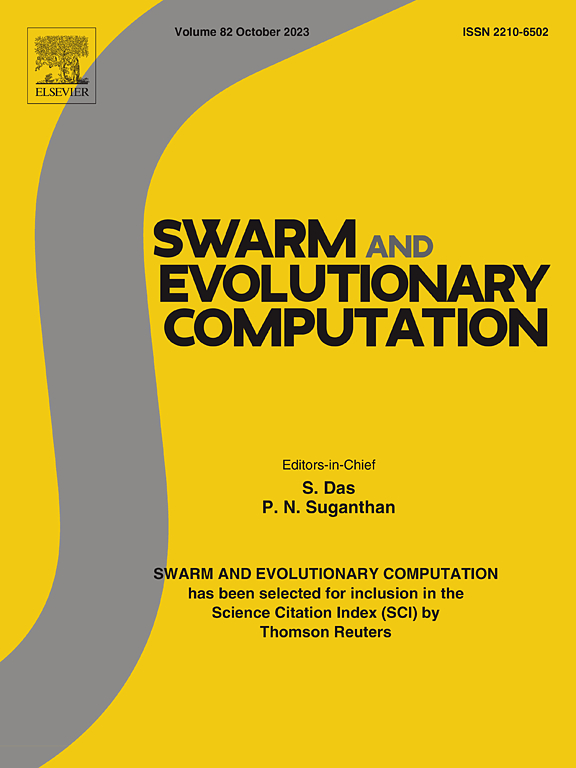进化神经结构搜索的列表排序预测器
IF 8.2
1区 计算机科学
Q1 COMPUTER SCIENCE, ARTIFICIAL INTELLIGENCE
引用次数: 0
摘要
在进化神经结构搜索(ENAS)中,准确度预测器(即回归模型)已被成功地应用于网络结构评估,从而节省了计算成本。然而,这些预测器的准确性在很大程度上受到少量可能难以获得的评估架构的限制。这种带有预测偏差的准确度预测因子通常会导致不准确的排名,误导ENAS的选择。为了缓解上述局限性,我们设计了一种高效新颖的ENAS列表排序预测器(LRP),直接预测每个结构的排名,而不是每个结构的数值精度值。具体来说,训练数据是由所提出的随机编码组合(REC)策略构建的,该策略可以使用少量的评估架构(数据级)生成大量的训练数据。这些专门构建的训练数据用于训练LRP, LRP可以将复杂的回归任务转化为排序任务,以减少排序偏差(模型水平)。在广泛使用的基准数据集和实际应用中,将所提出的NAS方法与现有的NAS方法进行了比较。实验结果表明,LRP能有效缓解排序障碍问题,在有效性和效率上都优于其他方法。本文章由计算机程序翻译,如有差异,请以英文原文为准。
Listwise ranking predictor for evolutionary neural architecture search
In evolutionary neural architecture search (ENAS), the accuracy predictors (i.e., regression models) have been successfully applied to save computational costs for the evaluation of network architectures. However, the accuracy of these predictors is largely limited by the small amount of evaluated architectures that may be difficult to obtain. Such accuracy predictors with prediction bias often lead to an inaccurate ranking, misleading the selection of ENAS. To alleviate the above limitations, we design an efficient and novel listwise ranking predictor (LRP) for ENAS to directly predict the ranking of each architecture instead of the numerical accuracy value of each architecture. Specifically, the training data is constructed by the proposed random encoding-combination (REC) strategy, which can generate substantial training data using the small number of evaluated architectures (data level). These specially constructed training data are used to train LRP, which can convert the complex regression task into a ranking task to reduce ranking bias (model level). The proposed NAS method is compared with state-of-the-art NAS methods on widely-used benchmark datasets and practical application. Experimental results demonstrate that LRP can alleviate the ranking disorder problem and outperform others in terms of both effectiveness and efficiency.
求助全文
通过发布文献求助,成功后即可免费获取论文全文。
去求助
来源期刊

Swarm and Evolutionary Computation
COMPUTER SCIENCE, ARTIFICIAL INTELLIGENCEC-COMPUTER SCIENCE, THEORY & METHODS
CiteScore
16.00
自引率
12.00%
发文量
169
期刊介绍:
Swarm and Evolutionary Computation is a pioneering peer-reviewed journal focused on the latest research and advancements in nature-inspired intelligent computation using swarm and evolutionary algorithms. It covers theoretical, experimental, and practical aspects of these paradigms and their hybrids, promoting interdisciplinary research. The journal prioritizes the publication of high-quality, original articles that push the boundaries of evolutionary computation and swarm intelligence. Additionally, it welcomes survey papers on current topics and novel applications. Topics of interest include but are not limited to: Genetic Algorithms, and Genetic Programming, Evolution Strategies, and Evolutionary Programming, Differential Evolution, Artificial Immune Systems, Particle Swarms, Ant Colony, Bacterial Foraging, Artificial Bees, Fireflies Algorithm, Harmony Search, Artificial Life, Digital Organisms, Estimation of Distribution Algorithms, Stochastic Diffusion Search, Quantum Computing, Nano Computing, Membrane Computing, Human-centric Computing, Hybridization of Algorithms, Memetic Computing, Autonomic Computing, Self-organizing systems, Combinatorial, Discrete, Binary, Constrained, Multi-objective, Multi-modal, Dynamic, and Large-scale Optimization.
 求助内容:
求助内容: 应助结果提醒方式:
应助结果提醒方式:


